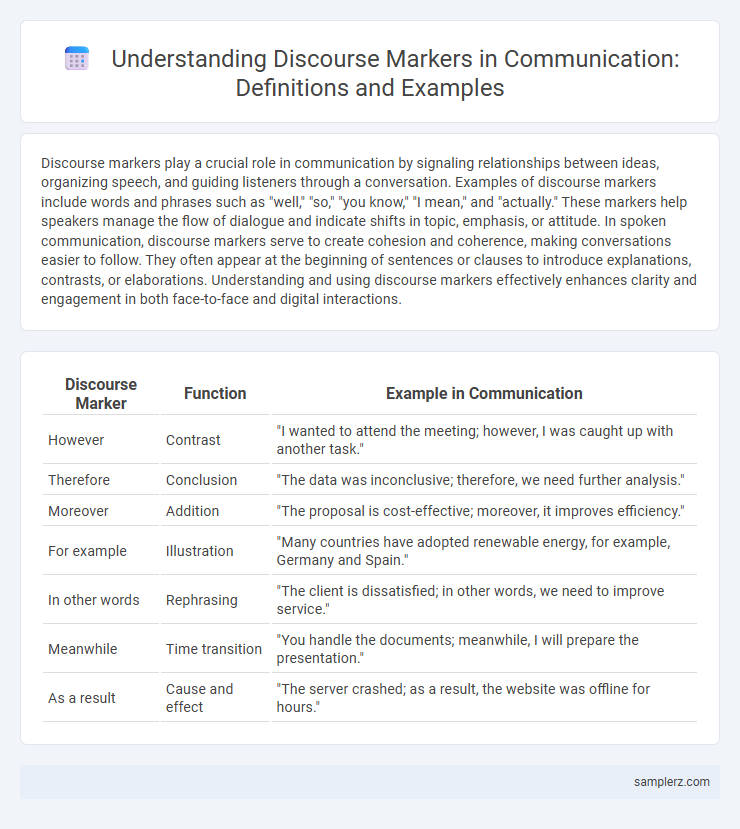Discourse markers play a crucial role in communication by signaling relationships between ideas, organizing speech, and guiding listeners through a conversation. Examples of discourse markers include words and phrases such as "well," "so," "you know," "I mean," and "actually." These markers help speakers manage the flow of dialogue and indicate shifts in topic, emphasis, or attitude. In spoken communication, discourse markers serve to create cohesion and coherence, making conversations easier to follow. They often appear at the beginning of sentences or clauses to introduce explanations, contrasts, or elaborations. Understanding and using discourse markers effectively enhances clarity and engagement in both face-to-face and digital interactions.
Table of Comparison
| Discourse Marker | Function | Example in Communication |
|---|---|---|
| However | Contrast | "I wanted to attend the meeting; however, I was caught up with another task." |
| Therefore | Conclusion | "The data was inconclusive; therefore, we need further analysis." |
| Moreover | Addition | "The proposal is cost-effective; moreover, it improves efficiency." |
| For example | Illustration | "Many countries have adopted renewable energy, for example, Germany and Spain." |
| In other words | Rephrasing | "The client is dissatisfied; in other words, we need to improve service." |
| Meanwhile | Time transition | "You handle the documents; meanwhile, I will prepare the presentation." |
| As a result | Cause and effect | "The server crashed; as a result, the website was offline for hours." |
Understanding Discourse Markers in Communication
Discourse markers such as "however," "therefore," and "meanwhile" play a crucial role in structuring spoken and written communication by signaling relationships between ideas. These linguistic tools enhance coherence, guide listeners through arguments, and aid in interpreting the speaker's intent. Mastering discourse markers improves comprehension, facilitates smoother interactions, and supports effective message transmission in diverse communicative contexts.
Common Types of Discourse Markers
Common types of discourse markers in communication include conjunctions like "and," "but," and "so," which help organize ideas and signal relationships between clauses. Other frequent markers are adverbs such as "however," "therefore," and "meanwhile," used to indicate contrast, cause-effect, or time sequence. Interjections like "well," "oh," and "you know" function to manage conversational flow and signal speaker attitudes.
Functions of Discourse Markers in Conversation
Discourse markers such as "well," "so," and "you know" serve crucial functions in conversation by signaling transitions, organizing speech, and managing interactions. These markers help speakers indicate topic shifts, emphasize points, and facilitate turn-taking, thereby enhancing the clarity and flow of communication. Understanding the functions of discourse markers improves conversational coherence and listener comprehension in various communicative contexts.
Examples of Additive Discourse Markers
Examples of additive discourse markers in communication include words and phrases like "and," "also," "furthermore," and "in addition." These markers enhance the flow of conversation by connecting ideas smoothly and emphasizing the accumulation of information. Effective use of additive discourse markers improves clarity and coherence in both spoken and written communication.
Illustrating Contrastive Discourse Markers
Contrastive discourse markers such as "however," "on the other hand," and "nevertheless" play a critical role in communication by signaling differences or contradictions between ideas. These markers guide the listener or reader through shifts in argument or perspective, enhancing clarity and coherence in discourse. Effective use of contrastive discourse markers improves the overall flow of communication, making it easier to compare and contrast viewpoints.
Discourse Markers for Sequencing Ideas
Discourse markers for sequencing ideas, such as "first," "next," and "finally," play a crucial role in organizing information logically during communication. These markers guide listeners or readers through a clear, structured flow of thoughts, enhancing comprehension and retention. Effective use of sequencing discourse markers supports coherent storytelling and structured arguments in both spoken and written communication.
Causal Discourse Markers in Communication
Causal discourse markers such as "because," "since," and "therefore" play a crucial role in communication by clearly indicating cause-and-effect relationships within conversations or texts. These markers enhance the clarity of arguments and explanations, helping listeners or readers understand the reasoning behind statements or actions. Effective use of causal discourse markers improves coherence and facilitates logical flow in both written and spoken communication.
Pragmatic Use of Discourse Markers
Discourse markers like "well," "you know," and "I mean" play a crucial role in pragmatic communication by signaling speaker attitudes, managing conversational flow, and indicating relationships between utterances. Their pragmatic use helps listeners interpret the speaker's intent, such as hesitation, emphasis, or topic shifts, enhancing clarity and coherence in dialogue. In real-life conversations, these markers facilitate smooth turn-taking and signal social cues, making interactions more effective and contextually appropriate.
Discourse Markers in Spoken vs. Written Communication
Discourse markers such as "well," "you know," and "I mean" frequently appear in spoken communication to manage turn-taking and signal hesitation or emphasis. In contrast, written communication tends to rely on more formal markers like "however," "therefore," and "on the other hand" to organize ideas and maintain cohesion. Differences in discourse marker usage reflect the spontaneous and interactive nature of speech compared to the planned and structured style of writing.
Tips for Effective Use of Discourse Markers
Using discourse markers such as "however," "therefore," and "for example" can significantly enhance clarity and flow in communication by signaling relationships between ideas. To use discourse markers effectively, ensure they are contextually appropriate, avoid overuse to prevent redundancy, and match the formality level of the conversation or text. Practicing varied placement within sentences and pairing markers with clear, concise content improves listener or reader comprehension and engagement.

example of discourse marker in communication Infographic
 samplerz.com
samplerz.com